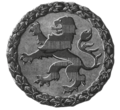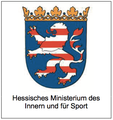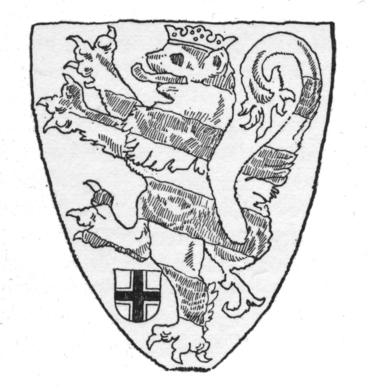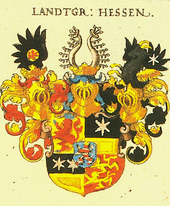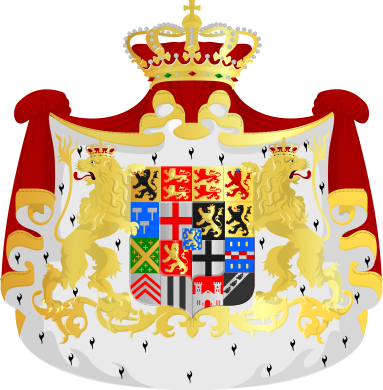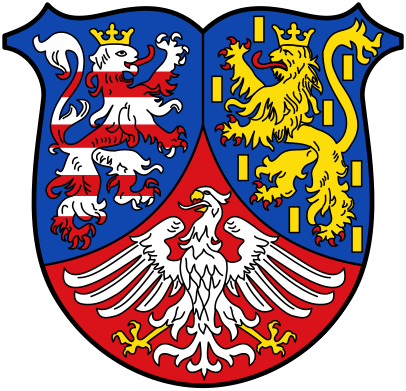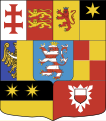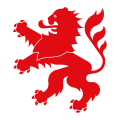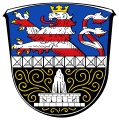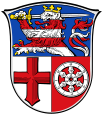State coat of arms of Hesse
The state coat of arms of Hesse shows in a blue shield a colored lion, divided by red and silver and reinforced with gold .
National emblem of the country
The national coat of arms is one of the national emblems of the country. The legal basis is the law on the emblems of the state of Hesse of August 4, 1948 . In 1949, this “National Emblem Act” was changed slightly - the change replaced the models attached to the law ; the 1948 samples were not yet adequately prepared for use. The national emblems are named in the first paragraph of the law: the state coat of arms , the state flag , the state service flag , the state seal , the official shield of the state authorities and the state cockade .
"§ 1 The state coat of arms shows a blue shield with a rising lion with golden claws, divided nine times in silver and red . On the shield rests a thread of golden foliage with fruits formed from blue pearls.
§ 2 (1) The national flag consists of an upper red and a lower white horizontal stripe; the height of the flag is related to its length as 3: 5.
(2) The national flag is also the trade flag.
(3) The state service flag is the state flag with the state coat of arms in the middle.§ 3 The state seal shows the heraldic figure, the lion.
§ 4 The official shield of the state authorities is a white rectangle on which the state coat of arms is located. Under the coat of arms, the name of the authority is attached in black letters without specifying the location.
§ 5 The state cockade is red and white. "
- Emblem of the State of Hesse
A representation of the national cockade is missing from the list of images of the national emblems.
The coloring of the state flag follows § 66 of the constitution of the state of Hesse from 1946: "The state colors are red and white."
History of the coat of arms
Early Middle Ages, "Hessen lion" and "Bunter Löwe"
The coat of arms of Hesse and the coat of arms of Thuringia go back to seals and coats of arms from the Middle Ages. The heraldic animal in both state coats of arms and in a number of other coats of arms is called the " colorful lion ". "Hesse lion" is the name of the lion in the state coat of arms of Hesse. This designation refers to the silver-red-striped heraldic animal with the knocked-out tongue in red. It is a lion divided nine times by silver and red (i.e. ten-lipped).
The lion was originally used by the Ludowingers , who were landgraves in Thuringia and who also ruled large parts of northern and central Hesse in the 12th and 13th centuries. It is still used in Hessen's coat of arms today.
The oldest depiction of the coat of arms is the one on the shield of Landgrave Konrad of Thuringia († 1240), Ludowinger Regent of Hesse (until 1234) and Grand Master of the Teutonic Order (from 1239). The shield temporarily hung in the Marburg Elisabeth Church as a death shield ; Meanwhile it is exhibited as an exhibit in a collection of the University Museum for Art and Cultural History of the Philipps University of Marburg in Marburg Castle .
The coat of arms of Konrad of Thuringia at the foot of his tomb in the Landgrave Choir of the Elisabeth Church in Marburg is slightly younger (probably 1240, the year of Konrad's death) - on the left the coat of arms of the Teutonic Order.
- Coat of arms of Konrad of Thuringia
Landgrave Heinrich I of Hesse (1244–1308), after the acquisition of Hessian territory in 1264, led the lion for the first time on his large equestrian seal, which was documented for 1269, as the "Hessian lion" in the shield. This is the first evidence of the Hessian lion as a coat of arms on a seal.
In addition to the shield of Landgrave Heinrich I, which only shows a rudimentary coloration of the coat of arms, the initial in the Willehalm Codex (1334, see picture on the left) is the first color representation of the Hessian coat of arms with the colorful lion.
The initial is at the beginning of the epic Arabel , a prehistory by Ulrich von dem Türlin to the epic Willehalm by Wolfram von Eschenbach in a splendid manuscript.
Ending Middle Ages and Modern Times
Until 1918, the ruler's coats of arms also represented the countries. The development of the Hessian princely coats of arms is typical of the custom of adding coats of arms of the newly acquired territories to the shield to make the shield more lush, but at the same time more confusing. First, the acquisition of the county of Ziegenhain with Nidda in 1450 led to an increase in the coat of arms : Initially in separate shields next to the lion, after 1471 in fields 2 and 3 of the quartered shield, Ziegenhain and Nidda appear. The attack of Katzenelnbogen with part of the old County of Diez in 1479 gave the next occasion to change the coat of arms. Like the death shield of Landgrave Heinrich III. from 1484 and heraldic books since 1492 show, one initially took in the four-sided shield except for Hessen and Nassau the looking lions of the Katzenelnbogen and the lions of Diez, formerly known as " Leopard ", and placed the Ziegenhain coat of arms in a heart shield .
From the Diet of Worms (1495) it is reported:
“After that, on the next day after Margarethen, Mr. Maximilian sat in Royal Majesty at Worms, with all the ornaments belonging to a Roman king in the presence of all prescribed princes, spirit and world. who then received their fiefs.
Item on Divisionis Apostolorum… are the two princes, Mr. Wilhelm the Mitler Landgrave of Hesse and the Lord [Wilhelm] the Younger Landgr. all come to Hessen .
The first is Johann Schenck zu Schweinsberg marshal come with the little racing flag , the same banner was white, and inside was the coat of arms for Hessen alone, and with it the king. Chair, with a nice cracked texture, is suitable.
From now on the two princes come, with 7 counts, gentlemen and with their knighthood, then on 300 horses, and have brought 2 banners, the first one carried size. Philips von Solms , that was a big red banner, in it was the coat of arms of Hesse in the middle and 5 arms around it.
- The first was Catzenehlnbogen.
- The other goat grove.
- the third waldeck.
- the fourth Dietz.
- The fifth nidda. "
In the 16th century, the order Katzenelnbogen, Ziegenhain, Nidda and Diez with the landgrave lion in the heart shield became commonplace. In addition to the Hessian helmet with the leafed buffalo horns , which until then was almost without exception in the coat of arms , there were also the crests of Katzenelnbogen and Ziegenhain.
The division of Hesse in 1567 had no heraldic consequences for a long time; the same coat of arms was used for the first four and then only two of the principal principalities ( Kassel and Darmstadt ). It was not until 1659 that heraldry emphasized the area growth brought about by the incursion of small Isenburg areas in 1642 and finally in 1648 the acquisition of the principality of Hersfeld and part of the county of Schaumburg : From then on, the signs for Hersfeld, Ziegenhain, Katzenelnbogen, Diez, Nidda, Isenburg and finally the Schaumburger nettle leaf, while the heart shield continued to show the Hessian lion. The extinction of the Hanau Princely House after 1736 caused the insertion of parts of its seven-field shield (with Bitsch , Hanau , Rieneck , Zweibrücken , Münzenberg , Ochsenstein and Lichtenberg ) into the coats of arms of the Landgraves of Kassel and Darmstadt as the heirs. Since 1774 the coat of arms of the Darmstadt line consisted of ten fields with a heart shield; since 1804 the number of fields including the heart shield had risen to 17, which illustrated the acquis prior to the elevation to the Grand Duchy (1806).
Landgraviate of Hesse
The coat of arms of the Landgraviate of Hesse (1247–1567) is passed down in Johann Siebmacher's coat of arms book from 1605.
It shows the "colorful lion" or the "Hessen lion" in the heart shield .
Landgraviate of Hessen-Darmstadt
The coat of arms of the Landgraviate of Hessen-Darmstadt (1567–1806) is divided and split twice , fields 3, 4, 5 and 6 are each divided:
- Principality of Hersfeld (former abbey, 1648 to Hessen-Kassel. Hessen-Darmstadt, even without gaining territory, followed suit heraldically and also depicted Hersfeld.): In silver a red patriarchal cross.
- Grafschaft Ziegenhain : divided by black over gold, with a six-pointed silver star on top.
-
- County Katzenelnbogen (1479 to Hessen): In gold, a red lion crowned in blue.
- Grafschaft Nidda (1450 to Hessen): Divided by black over gold, above two eight-pointed silver stars.
-
- Grafschaft Diez (1386 to Katzenelnbogen, after its extinction in 1479 to Hessen): In red two striding golden leopards on top of each other.
- Hanau (preserved in 1736 after the Counts of Hanau died out): Three red rafters in gold on top of each other.
-
- Grafschaft Schaumburg (1648 to Hessen-Kassel): In red, a little plate divided by silver over red, surrounded by a silver nettle leaf .
- Herrschaft Lichtenberg : Inside a red border a black lion, red armored and tongued.
-
- Grafschaft Isenburg-Büdingen : Two black bars in silver.
- Grafschaft Ochsenstein : Two red bars in silver.
Heart shield: In blue a gold-crowned and armored lion divided nine times by silver and red (Landgraviate of Hesse).
Grand Duchy of Hesse 1808
In the Hessian coats of arms the number of dividing lines on the lion changed for a long time and it was also different in the more recent coats of arms of Prussia and the Saxon states, although the nine-fold division had long been established for Hesse.
Silver for the top stripe didn't become the norm until the late 15th century. The helmet covers were initially blue and red (as in 1334), later mainly red and silver.
The addition of other territorial coats of arms to the Hessen lion, which appeared in the second half of the 15th century, was again dispensed with in the Grand Duchy of Hesse from 1808 to 1902.
Klemens Stadler writes:
“The great majesty coat of arms valid at this time contains the double-tailed, gold- armored lion, divided nine times by silver and red, with a gold royal crown, who wields a silver sword with a gold handle with his right front paw. It was meant to symbolically designate the honorary title used for the landgraves in the Middle Ages, 'Vorfechter between Rhine and Weser'. The royal crown rests on the shield and is repeated on the hermelin-lined purple canopy . Shield holders are two facing golden lions with royal crowns. The chains of the Order of Louis , founded in 1807, and the Order of Merit of Philip the Magnanimous are visible below the shield . Sometimes the chain of the Order of the Golden Lion is also found . A ribbon with the motto 'God, honor, fatherland' stretches underneath the base of the shield. "
The title "Vorfechter between Rhine and Weser" was an honorary title of the Holy Roman Empire .
The lion appeared for the first time with a royal crown and sword as an additional symbol of rank and dignity. For the first time in more than 500 years, the Hessian family coat of arms was fundamentally changed. It was introduced on July 29, 1808.
The armament with a sword and thus the departure from previous coats of arms was viewed critically by contemporaries. Ulrich Friedrich Kopp said in 1831:
“But old coats of arms also suffer, yes they are sometimes even destroyed if you change them. So it is a big mistake that one in the new Grand Duke. Hessen-Darmstädtischen Wapen [sic] put a sword in the paw of the lion (to make him a leader). Because then he ceases to be the old Thuringian and Hessian lion, and according to heraldic rules is now less than he was before. "
Bernhard von Koehne later criticized in a different way :
"If the coat of arms of a country is to be the symbolic representation of the history of the same, as required by the science of heraldry, not all coats of arms meet this requirement: in particular the coats of arms of Baden, Hessen-Darmstadt and the Kingdom of Saxony, which after removal of the the remaining fields only consist of the former middle shields, every heraldic value . "
Electorate of Hesse (1814–1866)
The Electorate of Hesse existed from 1814 to 1866. The Kassel line, which gained electoral dignity in 1803, used until its deposition in 1866 as a large coat of arms a shield that was split and divided twice , including the heart shield with the single-tailed, crowned lion, divided nine times by silver and red ( without sword) had a total of thirteen historical coats of arms:
- a black cross in silver (Principality of Fulda)
- divided; above quartered split of red and gold central shield (coins Berg), 1 and 4 in red gold three rafters (Hanau), 2 and 3, seven shared by red and gold ( county Rieneck ); below in gold a red lion (Katzenelnbogen)
- red patriarchal cross floating in silver ( Principality of Hersfeld )
- Goat grove
- Heart shield Hessen
- Nidda
- Golden cross floating in blue with a raised cross arm ( Principality of Fritzlar )
- divided; above in red two striding golden lions ( Grafschaft Diez ), below in red a silver nettle leaf , covered with a shield divided by silver and red ( Grafschaft Schaumburg )
- in silver two black bars (Isenburg)
Shield holder : Two golden lions with royal crowns. The little coat of arms was the heart shield, on it the royal crown.
- Coat of arms of the Electorate of Hesse
Nassau lion
The dynasties - Gender by Lauren Castle ( House of Nassau ) was called since the second half of the 12th century after the castle Nassau an der Lahn. Since 1255 there have been numerous divisions into lines, the nicknames of which corresponded to the main areas (e.g. Nassau-Weilburg , Nassau-Dillenburg , Nassau-Hadamar , Nassau-Usingen ) or new acquisitions (e.g. Nassau-Saarbrücken ). The elevations of the members of the entire house to the prince class began in 1650; In 1806 the principality became the Duchy of Nassau .
The lion with a shield border in two rows appears for the first time in Count Walram's seal before 1198. The shingles typical of the Nassau shield , with which the field is sprinkled irregularly , appear as a seal since 1221 and were undoubtedly a sign to distinguish the coat of arms of Count Heinrich II. From that of his brother Ruprecht IV. They initially had a high rectangular shape, but became later usually shown sloping, sometimes also horizontal or inclined; it was not until the late 18th century that office heraldry established their number. The Nassau lion has been crowned gold since the 15th century, and its red reinforcement was confirmed again in 1783. The gold tinging for the lion and the shingles and blue for the field have been established since the earliest records. A semicircular umbrella board , the surface of which is divided by seven curved lines, has been known as the first helmet ornament since the early 14th century . In 1353 the later predominant helmet ornament was introduced: a seated lion between two shingle-strewn blue buffalo horns; it went to fiefdom from the Palatinate electors . The helmet covers are blue and gold.
- Nassau lion in historical coats of arms (examples)
Counts of Nassau in Scheibler's book of arms
Prussian Province of Hessen-Nassau
The emblem of the Prussian province of Hesse-Nassau was not taken into account when the state coat of arms was created in 1948 . It was created in 1892 in the course of the introduction of the Prussian provincial coats of arms and combined three old coats of arms of important territories: Split by a curved red tip , inside a gold- reinforced silver eagle (former Free City of Frankfurt ); on the right, in blue, a left-turning, golden-crowned lion, seven times (according to Prussian tradition!) divided by silver and red (Hessen-Kassel); on the left in blue a golden crowned, red armored golden lion between golden shingles (Duchy of Nassau). In the larger coat of arms, a wild man with the Prussian king standard was attached to the shield as a shield holder , on the left an armored knight with the provincial standard , in it the provincial coat of arms ; on the shield two golden crowned spangen helmets with the helmet decorations of Hessen (but with green birch leaves) and Nassau (in the newer design described above); the helmet covers on the right red, silver; left blue, golden.
- Coat of arms of the Prussian province of Hessen-Nassau
Grand Duchy of Hesse 1902
The state coat of arms of the Grand Duchy of Hesse from 1808 was originally intended only as an "interim" regulation and was never published with an official description. Small (unofficial) adjustments to the design of the coat of arms had been made throughout the 19th century . This situation, which was widely perceived as unsatisfactory, was ended by Grand Duke Ernst Ludwig .
With its ordinance of December 9, 1902, the previous state coat of arms from 1808 was repealed and replaced by two new ones. From then on there was a large and a small state coat of arms in the Grand Duchy of Hesse.
Large national coat of arms
For the Grand Duchy of Hesse, the ordinance on the large state coat of arms meant a relapse into the heraldic practices of the 18th century, after the Hessian lion had been the only symbol for almost a century.
"I. The main shield, split and divided twice , has a heart shield .
- 1) The heart shield shows the shield of the Grand Ducal small national coat of arms : in blue a lion with tenfold stripes of silver and red , crowned and armored in gold, also armed with a silver sword in a gold handle.
- 2) The first place of the main shield shows in blue a lion striped ten times in silver and red, crowned and reinforced in gold because of the Landgraviate of Hesse .
- 3) Second place : in red, a silver wheel with six spokes, because of the former imperial principality of Mainz .
- 4) Third place : a slanted silver key in a black field sprinkled with golden crosses , because of the former imperial principality of Worms .
- 5) The fourth place : divided by black and gold, above a six-pointed silver star, because of the former County of Ziegenhain .
- 6) The fifth place is covered by the heart shield (see under 1).
- 7) The sixth place shows in gold a red leopard with a blue crown, tongue and claws, because of the former County of Katzenelnbogen .
- 8) Seventh place : two black bars in silver, because of the county of Büdingen .
- 9) The eighth place : of red and gold eight times rafter as divided, because the former county Hanau .
- 10) The ninth place : divided by black and gold, above two eight-line silver stars, because of the county of Nidda .
II. On the shield are five jewels wearing buckle helmets .
- 1) The crowned helmet in the middle bears two buffalo horns made of silver and decorated with linden branches . Red and silver helmet covers . Because of the Landgraviate of Hesse .
- 2) Red velvet hat with white face plate , sullied with sechsspeichigem silver wheel. Helmet covers red and silver. Because of Mainz .
- 3) Crowned, black flight , which is covered with a golden disc in which the coat of arms of Katzenelnbogen (I, 6) appears. Red and gold helmet covers.
- 4) Growing winged black goat with silver horns and claws; the wings divided by black and gold, above a silver star. Black and gold helmet covers. Because of the goat grove .
- 5) Growing silver swan with a golden beak. Silver and red helmet covers. Because of Hanau .
III. As a shield holder : two golden crowned lions, red-tongued and armored, standing on green ground. "
Small national coat of arms
Even after the complete redesign of the large coat of arms in 1902, the sword-swinging Hessian lion remained the sole content of the small state coat of arms. The grand ducal crown lies on its shield. It consists of a frost leaves occupied and closed with two half sheets that above the orb carry.
Description of coat of arms:
“In the blue shield there is a lion, striped ten times in silver and red, crowned and armored in gold, also armed with a silver sword in a gold hilt. On the shield rests a two-bowed golden royal crown decorated with pearls and stones. "
The small national coat of arms is a design by the heraldist Otto Hupp (1859–1949), who also designed numerous other coats of arms, such as the Bavarian state coat of arms from 1923.
Hupp took up the design of the lion from 1808 in his design . He only changed two elements. On the one hand, the lion's crown is shown again without a bow, especially since a two-bowed royal crown rests on the shield. On the other hand, the position of the sword is adapted to the more upright posture of the right lion paw holding it.
Thus the sword takes an almost horizontal position, which is to be found in all representations of the Hessian coat of arms until the end of the monarchy.
For the first time, the number of stripes of the lion was officially set.
People's State of Hesse
On April 20, 1920, the People's State of Hesse (1918–1945) received a new coat of arms. On the coat of arms the silver-red striped lion can be seen on a blue field. Above it sits golden foliage with blue fruits in the shape of a crown.
This coat of arms is also a design by the heraldist Otto Hupp. Together with his design for a seal stamp (round shape, diameter 4 cm), both designs were officially decreed by the Hessian Ministry of General Affairs:
- Designs by Otto Hupp
The Landgraviate of Hessen-Darmstadt and the subsequent Grand Duchy put a sword in the lion's paw; However, this disappears together with the lion's crown, so that the Landtag of the People's State of Hesse, elected after the deposition of the Grand Duke and the proclamation of the Republic on January 26, 1919, now adopted a "reduced" version of the lion, which has been retained for almost 750 years, as the national coat of arms.
After the overthrow of the monarchy, the new people's state of Hesse gave itself the lion as the sole symbol, but now uncrowned and without the dynastic attributes. Likewise, the misleadingly introduced sword in the lion's paw was dropped again. The only accessory that was added above the shield was the people's crown to emphasize the sovereignty of the people .
The current coat of arms of the country sticks to that of the People's State from 1920 with only insignificant stylistic simplifications; however, the official blazon avoids the expression “people's crown”.
After 1945
History of origin
The current state coat of arms is a design by the East Prussian- born artist Gerhard Matzat (born November 24, 1921 in Ragnit an der Memel ; † November 19, 1994), which he designed in 1949 following a competition for the newly formed state of Hesse. Matzat based the design on historical models. He studied from 1946 to 1953 at the Städelschule art college in Frankfurt am Main - there he was a student of Wilhelm Heise and Georg Meistermann . In addition to the Hessian state coat of arms, he also designed the Hessian state seal.
As early as 1945, the first drafts for the design of a new state coat of arms were accepted by the US military government and the Hessian State Archives - they were unsuccessful.
Other designs were results of a competition, which the Minister of Culture and Education in March 1947 awarded had:
“The Hessian State Ministry endeavors to create a national emblem that symbolically expresses the dignity of democracy and at the same time the characteristic and timeless traditions of the State of Hesse.
In doing so, the existing should just as little be taken over unreservedly as the new should only be created for the sake of the new. The symbol should grow out of the cooperation of the people. The cabinet has therefore decided to launch a public competition to obtain a national emblem. "
The task was to design the following national emblems:
- a state coat of arms;
- a state service flag, which consists of an upper red and a lower white horizontal stripe and shows the state coat of arms in the middle;
- an official sign. It should consist of a white rectangle on which the state coat of arms is located. Under the coat of arms, the name of the authority is affixed in black letters without specifying the place; z. B. The Prime Minister, District Court.
- a state seal showing the state's coat of arms;
- a country cockade.
One of the requirements was that the designs must be free of "dynastic and militaristic features (crown, helmets, swords, oak leaves, etc.)". April 30, 1947 was given as the deadline for submission. Three prizes were offered: 1500 Reichsmarks (RM) for the 1st prize, 1000 RM for the 2nd prize and 500 RM for the 3rd prize. A jury decided on the distribution of the prizes. It included:
" Minister of Education Dr. Stein , Wiesbaden;
Prof. Dr. Wilhelm Heise , come on. Director of the Frankfurt Art Academy ;
Dietrich N. Evers, painter and graphic artist, Wiesbaden;
Clemens Schmidt , painter and graphic artist, Wiesbaden;
Dr. Korn , Director of the State Archives, Düsseldorf ;
Dr. Holzinger, Director of the Hessian Museums, Frankfurt am Main;
Dr. Sante , director of the Wiesbaden State Archives ;
Dr. Clemm , director of the Darmstadt State Archives ;
Professor of History Dehio , Marburg an der Lahn ;
Professor of History Uhlmann, Marburg an der Lahn;
Reg.-Pres. Prof. Dr. Bergsträßer , Darmstadt, M. d. L .;
Lord Mayor Dr. Raabe , Fulda, M. d. L .;
Schulrat Karl Gaul , Frankfurt, M. d. L .;
Mr. Leo Bauer , Frankfurt, M. d. L. "
Three artists were honored for their designs in June 1947: Adolf Jäger from Frankfurt am Main, Eduard Gärtner from Frankfurt am Main and Winfried Schaaf from Wiesbaden. In addition, the artists each received 1,000 RM for follow-up orders. Both the award-winning drafts and the drafts that emerged as a result turned out to be unsuitable: “The jury agreed that none of the three drafts met the requirements in terms of heraldry and art and that the award was only given in order to make use of the submitted works best honored. ”In September 1947, the uselessness of all the drafts that the award winners had been commissioned was determined. In December 1947, the jury regarded the competition only as a competition of ideas, to consider the commissioning of any artist to be too uncertain and a fair competition to be feasible only when the heraldic regulations were established, i.e. H. a coat of arms law has been passed by the state parliament. The law on the emblems of the state of Hesse came into force on August 4, 1948. At that time there was still no artist who could submit a suitable design. On November 29, 1948, the representative of the State Archives in Wiesbaden wrote to the Minister of Education: "It is also regrettable that, despite long efforts, it has not been possible to find a coat of arms painter who is able to combine the application of a modern style with the realities of heraldic laws".
“Until 1945 there were a number of Hessian state coats of arms [...] which already showed red and white striped lion figures rising to the right. [...] After the end of World War II, the design of a new state coat of arms, for which the US military government and the Hessian State Archives began unsuccessfully first work in 1945, was preceded by a competition in March 1947 by the Hessian State Ministry for Culture and Education . [...] The designs for the state coat of arms then submitted as part of the competition were not considered suitable by the jury. At the same time, the jury voted in its session on June 3, 1947 [...] for the retention of the white and red striped and upright to the right Hessian lion on a blue background without a crown and sword and 4 claws (including a so-called wax claw) in the future State coat of arms. In addition, the minutes of the meeting on the question of the detailed design of the lion stated that this should be left to the artist's feeling. As a result, initially no model of a new state coat of arms could be found that found the approval of the people appointed to make decisions.
Section 1 of the 'Law on the State Emblems of the State of Hesse' of August 4, 1948, which was passed in the meantime, read: 'The state coat of arms shows in the blue shield a rising lion with gold claws, divided into nine silver and red sections. On the shield rests a thread of golden foliage with fruits formed by blue pearls. '
The law of August 4, 1948 was accompanied by an [...] model of a state coat of arms, which, as evidenced by the memorandum of September 30, 1948, went back to an unnamed employee of a land surveying office without the involvement of the Ministry of Education and the State Archives which gave rise to criticism from the State Archives, the Ministry of the Interior and the Ministry of Culture. At the end of 1948, the Ministry of Culture therefore asked the ' Städelschule - State University of Fine Arts ' in Frankfurt am Main and the Art School in Kassel for drafts for official seals and state coats of arms. The director of the Städelschule, Professor Heise, who was also a member of the jury, then submitted corresponding designs in February 1949, on which Gerhard Matzat had also worked as his 'master student' and which gave the Städelschule the opportunity to submit samples for to ask for the coat of arms. In September 1949, Professor Heise then also submitted a colored draft by Gerhard Matzat for the state coat of arms, which was approved by the Ministry of the Interior and finally in the 'Special Supplement 1' to the 'Law to amend the law on the emblems of the State of Hesse of November 22, 1949' as the state coat of arms has been published. Section 1 of the Amending Act of November 22, 1949 regulated that the model of the state coat of arms published in the supplement to the law of August 4, 1948 was replaced by the model now published in 'Special supplement 1'. "
Gerhard Matzat was subsequently commissioned to produce single-color variants. In May 1949, Matzat received remuneration of 300 DM for his work on the drafts for the state seal . From 1992 until his death in 1994, the state of Hesse paid Gerhard Matzat an " honorary salary " of DM 2,000 per month in recognition of his services to the creation of the state coat of arms . Since Matzat's death, the state of Hesse had paid the "honorary salary" in the form of a widow's pension of 1,000 DM per month or later 500 DM to the widow. In a letter dated May 5, 1992 to the then Hessian minister of education, Gerhard Matzat expressed his thanks for the honorary salary, described "the completely unexpected donation from the country" as "one of the biggest surprises in my life", and contributed to the earlier circumstances the design of the state coat of arms and the demands placed on him, as well as the fact that he naturally made the greatest effort in implementing the order; He also expressed his satisfaction that his design had lasted for years and announced the implementation of further projects.
Copyright dispute
In a copyright dispute between the artist Avietta Nikolajevna Matzat-Rogoshina, widow of Gerhard Matzat, and the state of Hesse, the widow filed a lawsuit against the state in July 2013. The subject matter was that the plaintiff, as the legal successor of her deceased husband, demanded that Gerhard Matzat should be named as the author of the Hessian coat of arms, that the plaintiff should be paid damages for the "decades of failure to name the artist", information on the type and scope of the use of the To provide drafts, to pay a share after the information provided to the plaintiff, to pay further damages and to reimburse extrajudicial costs. The claimant put the amount in dispute at 1,500,000 euros. The topic received media attention back in February 2013.
The widow submitted an application for legal aid , which was rejected by the Frankfurt am Main regional court . In the legal aid proceedings, the applicant had asserted copyright claims in connection with the use of the state coat of arms with the State of Hesse. She was of the opinion that the use of Gerhard Matzat's design by the State of Hesse violated Matzat's copyrights:
“The design of the coat of arms was Matzat's individual intellectual creation, his copyrighted work, the necessary level of creation was given, it was an artist's work with intellectually differentiated content. It is not for nothing that an artist who is capable of expressing feelings and not a draftsman who moves in familiar paths has become active. The design, which despite all the specifications was difficult and not an easy artistic task, unlike earlier designs by third parties, expresses a modern spirit in the service of the dignity of democracy. Gerhard Matzat used public domain elements from older models in a completely new way when designing the state coat of arms, taking into account the specifications and traditional heraldic elements, including the rising lion in particular. At Matzat, this was preceded by a long opinion-forming process as well as an examination of heraldry, the history and coat of arms of Hesse and the new democratic order. The heraldic consideration of older coats of arms models and the specifications made by the applicant do not result in a reduction to a mere handicraft. Matzat has set himself apart from all previous designs. In Matzat's design, the lion appears in a completely new, simplified, calmed and energetic, peaceful form. There are considerable differences to a naturalistic lion representation and the lion representations used up to then in the earlier state coats of arms, in particular to the lion from the so-called Kurhessian coat of arms. Specifications would not conflict with the authorship. [...] There were never any discussions with Gerhard Matzat about a license agreement, there was no order in the legal sense, Matzat did not authorize anyone, never assigned his transferable claims under copyright law and never waived claims for remuneration. An implied conclusion of a contract could not be inferred from the circumstances, there was an imbalance between Matzat and the respondent, Matzat did not have to contradict the publication, the respondent was arguing here, as it were, in the spirit of the regime that fell in 1945. Even as a master class student at the Städel, he had no obligation whatsoever there. The payment of DM 300, - was made at will without a contractual basis and also only as a reward for the drawings of the state seal. "
The respondent, the State of Hesse, had announced a motion to dismiss the intended action and took a different view:
"The respondent, who objects to the statute of limitations against claims for damages, believes that Matzat's draft lacks the level of creation necessary for copyright protection. Because of the intended use, the design of the coat of arms could only be protected as a work of applied art under increased demands on the height of creation ; the design did not meet these requirements. The design elements can be found in the previously known coat of arms designs, in the stipulation in § 1 of the 'Law on the Emblem of the State of Hesse' of August 4, 1948, as well as the requirements of the jury that there was only minimal design leeway. Matzat's design, which was based on these historical patterns and specifications, was a commissioned work, was said to be very similar to the lion coat of arms of Thuringia used from 1933 to 1945 [...] and the central lion motif in the coat of arms of the Electorate of Hesse. Within the framework of the specifications and templates, high-quality, but only manual skills and no individual intellectual creation Matzat were used in the design. In the letter of thanks for his honorary salary, Matzat himself expressed that he had only a minimal amount of leeway.
She also thinks that any copyright Matzats on the draft coat of arms published as part of a law according to § 5 UrhG was lost.
In addition, with the delivery of the design by Matzat to them, under all circumstances at least a tacit transfer of the rights of use without restriction in terms of time and space . Matzat, who from the beginning was aware of the special purpose of his design as a national emblem and the corresponding actual use in the following, had agreed to the use of his coat of arms as the state coat of arms; He expressed this again with the letter of thanks from 1992 on the occasion of the honorary salary. In the case of intended use as a national emblem from the outset, it is incompatible with custom and the purpose of use if rights of use are retained. It also follows from the planned use as a national emblem and the function of national emblems that Matzat has tacitly waived the copyright. In any case, Matzat's behavior rules out any fault on the part of the respondent. There are no contractual claims to further remuneration. "
The application for legal aid was rejected because the action intended by the plaintiff does not have a sufficient chance of success, with reference to Section 114 of the Code of Civil Procedure . The plaintiff had lodged a complaint against this decision of the regional court. This complaint was rejected by the Frankfurt am Main Higher Regional Court . As a result, the plaintiff filed a constitutional complaint with the Federal Constitutional Court in September 2014 for violating several fundamental rights . Nothing is currently known about the result of this constitutional complaint (as of September 2017).
Further historical coats of arms
Coat of arms of the Landgraviate of Hessen-Homburg (1736–1866)
Coat of arms of the Landgraviate and the Grand Duchy of Hesse-Darmstadt (1804–1808)
Coat of arms of the House of Hessen-Rotenburg (1834)
Coat of arms of the Landgraviate of Hessen-Philippsthal (around 1866)
Coat of arms of the Landgraves of Hessen-Kassel-Rumpenheim (after 1917)
Coat of arms of the Hanau-Hořovice dynasty
Sovereign uses
The use of the national emblems is regulated in the ordinance on the national emblems of the state of Hesse (national emblem ordinance) .
State coat of arms and state service flag
The state coat of arms and the state service flag are carried by the Hessian state parliament as well as the authorities and courts of the state of Hesse.
The flagging of service buildings is only permitted by order. In addition to the state service flag, only the federal flag may be set to the right of the state service flag (seen from the front of the building). The state coat of arms must be embroidered or printed on both sides of the state service flag so that the lion's gaze is directed towards the flagpole. There are regular flagging dates :
| date | occasion |
|---|---|
| January 27th | Day of Remembrance for the Victims of National Socialism |
| 1st of May | Labor Day |
| May 9 | Europe day |
| 23. May | Anniversary of the proclamation of the Basic Law |
| 17th of June | Anniversary of June 17, 1953 |
| 20th of July | Anniversary of July 20, 1944 |
| 2nd Sunday in September | Remembrance day for the victims of flight, displacement and deportation and Homeland Day in Hesse |
| October 3 | Day of German unity |
| 2nd Sunday before 1st Advent | Memorial Day |
| December 1 | Anniversary of the entry into force of the constitution of the state of Hesse |
On the day of commemoration for the victims of National Socialism and on the day of national mourning, the flag must be half- masted. In addition, there is a flag on the days of general elections:
Flags for other special occasions are determined and announced by the Ministry of the Interior and for Sport .
State seal
The state seal is used in two versions:
- The "large state seal" is an embossed seal and shows the coat of arms of the country without inscription, surrounded by a thread of foliage. It is only managed by the highest state authorities and the highest courts of the state and by the highest state authorities for formal notarizations, in particular for the execution of laws, ordinances and appointments, by the highest courts of the state for the execution of judgments and by the president or generally determined by the President of the Court.
- The "small state seal" shows the coat of arms of the country with a legend indicating the place carrying the seal. It is used as an embossing seal, seal mark or color stamp (made of metal or rubber). The small state seal is used by the Hessian state parliament, the authorities and courts of the state of Hesse, the heads of state schools and universities, the notifying persons authorized to use an official seal and the registry offices.
National colors
The national colors "red and white" may be used for festive occasions and public events to decorate interiors or be shown outdoors on a pole or on house fronts.
Hessen sign
Since the coat of arms can only be used by the Hessian authorities due to its sovereign function, the state introduced the "Hessen Sign" on February 19, 1981, which can be used freely. With this, the administration of the state of Hesse complied with the request of private individuals, associations and companies to express their ties to the state with a symbol. The heraldic symbol consists of the slightly modified and stylized heraldic figure of the lion and can be used either in black or in the national colors red or white.
Further uses of the Hessen lion
The Hessen lion is depicted in many coats of arms of corporations in the federal state of Hesse and thus embodies the affiliation to the state . Either he is fully represented or he is growing (half lion, only upper body). In part he is crowned , in the Heppenheim case he wields a sword.
- The Hessen lion in coats of arms of Hessian municipalities and districts (examples)
Further examples of coats of arms of Hessian and Thuringian corporations with uses of the "colorful lion" can be found in the article colorful lion .
literature
- Jacob Hoffmeister: Historical development of the electoral Hessian coat of arms. Association for Hessian History and Regional Studies, Cassel 1844; 2nd edition, reviewed and completed by the author. Hühn, Kassel 1885.
- Jacob Christoph Carl Hoffmeister: Historical development of the electoral Hessian joint coat of arms. 2nd Edition. Cassel 1885.
- Otto Posse : The seals of the Wettins and the Landgraves of Thuringia. 1888.
- Hugo Gerard Ströhl : German coat of arms roll. Contains all coats of arms, standards, flags, national colors and cockades of the German Empire, its federal states and ruling dynasties . Julius Hoffmann, Stuttgart 1897, p. 21, 36 ( digitized version [ DjVu ]). Panels shown again: Jürgen Arndt: Coats of arms and flags of the German Empire and its federal states (1871–1918) . 1st edition. Harenberg Kommunikation, Dortmund 1979, ISBN 978-3-921846-81-0 .
- Viktor Würth: The Grand Ducal Hessian coat of arms in its historical development. Darmstadt 1917.
- Klemens Stadler : The municipal coat of arms of the state of Hesse . New edition of the collection of German local coats of arms by Otto Hupp on behalf of HAG Aktiengesellschaft in Bremen, edited by Dr. Klemens Stadler, drawings by Max Reinhart (= German coat of arms - Federal Republic of Germany . Volume 3 ). Angelsachsen-Verlag, Bremen 1967.
- Hans-Enno Korn : The Hessian Lion. In: Alma mater philippina. WS 1981/82, Marburg 1981, pp. 1-3.
- Walter Heinemeyer : On the history of the Hessian state coat of arms. In: Walter Heinemeyer (Hrsg.): Becoming Hessens. (= Publications of the Historical Commission for Hesse. Volume 50). Marburg 1986, pp. 813-828.
- Ottfried Neubecker : Heraldry. Munich 2002, here in particular the chapter “The Lion” (pp. 90–101).
- Dieter Emrich: 60 years of the Hessian coat of arms. History, precursors, origins. In: History sheets district Bergstrasse. 42, 2009, pp. 177-200.
- Gerhard Pons: Sixty Striped Years. The story of the Hessen lion. Manuscript (53 pages), self-published by the author, Limburg 2010.
- Gert Oswald : Lexicon of Heraldry. From apple cross to twin bars. 3rd unchanged edition, Regenstauf 2011, here the entries “colorful lion” (p. 83) and “lion” (p. 259 f.).
- Hartmut Heinemann: Our state coat of arms. In: Hessen - then and now. 60 years of the Hessian State Center for Political Education. Leaflet, No. 5, Wiesbaden 2014.
Web links
- Bernhard Peter: Monographs: The development of the coat of arms of the Landgraves of Hessen. In: welt-der-wappen.de.
- Lars Adler : The Hessian lion - from the landgrave's family coat of arms to the Hessian state symbol. In: hessen.de.
References and comments
- ↑ a b c d e Law on the National Emblems of the State of Hesse of August 4, 1948 . In: Hessisches Staatsministerium (Hrsg.): Law and Ordinance Gazette for the State of Hesse . 1948 no. 21 , p. 111 ( online at the information system of the Hessian state parliament [PDF; 394 kB ]). ; identical to the current version .
-
↑ a b Law amending the law on the national emblems of the State of Hesse of November 22, 1949 . In: Hessisches Staatsministerium (Hrsg.): Law and Ordinance Gazette for the State of Hesse . 1949 no. 44 , p. 171 ( online at the information system of the Hessian state parliament [PDF; 999 kB ]). In the system are u. a. Samples of the state coat of arms, the state service flag and examples of official signs of the state authorities provided. In special supplement 1 , the signature of the state coat of arms ("Design: Gerhard Matzat, Städelschule Frankfurt am Main. ") Shows that Matzat designed the state coat of arms.
- ↑ The term “thread” in the sense of “bundle, mesh of flowers” is used in heraldry - see thread (heraldry) in the Heraldik-Wiki.
- ↑ The lack of a state cockade in the sources examined (laws and guidelines) can be interpreted in such a way that a graphic design of a cockade has not taken place.
- ^ Constitution of the State of Hesse of December 11, 1946 . In: Landesregierung (Ed.): Law and Ordinance Gazette for the State of Hesse . 1946 No. 34 , p. 229 , § 66 ( online at the information system of the Hessian state parliament [PDF; 1,4 MB ]).
- ↑ a b c d timetable. In: hessen.de. State of Hesse, accessed on October 27, 2017 .
- ↑ a b c d e f g h i Klemens Stadler: The municipal coat of arms of the state of Hesse. Bremen 1967, see literature .
- ↑ 'Margarethen': probably July 20th, commemoration day of Margaret of Antioch , see also holidays and commemorations of July 20th
- ^ "Divisionis Apostolorum": July 15th
- ↑ a b c Gustav Adelbert Seyler : History of Heraldry. Introductory volume to Johann Siebmacher's Great Book of Arms. Nuremberg 1885–1889, ( digital copy of the 1970 reprint [PDF]).
- ↑ a b The new national coat of arms from 1902. In: hessen.de. Retrieved October 25, 2017 .
- ↑ Stadler 1967 calls the velvet hat "Fürstenhut".
- ↑ a b Ordinance relating to the state coat of arms of December 9, 1902 . In: Ernst Ludwig by the grace of God Grand Duke of Hesse and Rhine etc. etc. (Ed.): Großherzoglich Hessisches Regierungsblatt. 1903 no. 6 , p. 19 ff ( online at the information system of the Hessian state parliament [PDF; 23.0 MB ]).
- ↑ Ordinance concerning the state coat of arms for the people's state of April 20, 1920 . In: Hessisches Gesamtministerium (Hrsg.): Hessisches Regierungsblatt. 1920 No. 11 , p. 78 ( online at the information system of the Hessian state parliament [PDF; 28.4 MB ]).
- ^ Dieter Emrich: 60 years of the Hessian coat of arms. History, precursors, origins. In: History sheets district Bergstrasse. 42, 2009, pp. 177-200. Quoted from: New coat of arms for the people of Hessen, February 20, 1920. Contemporary history in Hessen (as of August 29, 2017). In: Landesgeschichtliches Informationssystem Hessen (LAGIS). Hessian State Office for Historical Cultural Studies (HLGL), accessed on October 23, 2017 .
- ↑ biography. In: Gerhard Matzat - official homepage. Retrieved September 11, 2017 .
- ↑ a b c d e f Regional Court Frankfurt am Main: Decision in the legal aid proceedings of Ms. Avietta Nikolajevna Matzat-Rogoshina against the State of Hesse. ( Memento from March 18, 2017 in the Internet Archive ) December 30, 2013. The 18-page PDF document is incomplete.
- ↑ a b c Competition for the design of the Hessian national emblem from March 20, 1947 . In: The Hessian Minister for Culture and Education (Hrsg.): State Gazette for the State of Hesse. 1947 no. 13 , p. 121 , point 155 ( online at the information system of the Hessian state parliament [PDF; 3.1 MB ]).
- ^ Minutes of the jury meeting on June 3, 1947, quoted from: Attorney Helga Müller: Application to the Frankfurt am Main Regional Court. ( Memento of March 18, 2017 in the Internet Archive ) on behalf of Ms. Avietta Nikolajevna Matzat-Rogoshina, widow of Gerhard Matzat, p. 6, July 5, 2013.
- ^ Note from Section XII of the Ministry dated September 8, 1947 according to the files of the Hessian Main State Archives HHStAW Dept. 504 No. 773 and HHStAW Dept. 404 No. 1839, quoted from: Attorney Helga Müller: Application to the Regional Court Frankfurt am Main. P. 7.
- ↑ Minutes of the jury of December 16, 1947, quoted from: Attorney Helga Müller: Application to the Frankfurt am Main Regional Court. P. 7.
- ↑ a b c Attorney Helga Müller: Application to the Frankfurt am Main Regional Court.
- ↑ Another letter from the lawyer from October 2013 is known of the copyright dispute, in which u. a. Further details of the situation in the post-war years are presented: Statement on the statement of defense. ( Memento of March 18, 2017 in the Internet Archive ), PDF, 91 pages.
- ↑ Volker Schmidt: Hesse coat of arms - Hesse should pay for the lion. In: Frankfurter Rundschau online. February 8, 2013, accessed February 12, 2013 .
- ↑ Olaf Schiel, Helmut Möller: Huge row over our coat of arms - artist widow wants money for Hessen-Löwe. In: Bild.de (regional edition Frankfurt). February 7, 2013, accessed on September 11, 2017 (with a photo showing various designs of the state coat of arms and a portrait photo of Gerhard Matzat).
- ↑ Attorney Helga Müller: Complaint against the decision of the regional court of December 30, 2013 ( Memento of March 18, 2017 in the Internet Archive ) February 4, 2014.
- ↑ decision in complaint Avietta Nikolaevna Matzat-Rogoshina against the State of Hesse . ( Memento from March 18, 2017 in the Internet Archive ; PDF) Higher Regional Court Frankfurt am Main, August 15, 2014.
- ^ Attorney Helga Müller: Constitutional complaint to the Federal Constitutional Court . ( Memento of March 18, 2017 in the Internet Archive ; PDF) September 24, 2014.
- ^ Ordinance on the national emblems of the State of Hesse (national emblem ordinance) . In: Hessenrecht - legal and administrative regulations . September 11, 2014.
- ↑ Sections 1 and 4 of the National Emblem Ordinance
- ↑ Circular - Subject: Execution of the ordinance on the state service flag of November 26, 1949 of December 31, 1949 . In: The Hessian Minister of the Interior (ed.): State Gazette for the State of Hesse. 1949 no. 52 , p. 537 , point 929 ( online at the information system of the Hessian state parliament [PDF; 2.2 MB ]).
- ↑ Hessian Ministry of the Interior and Sports: Flagging dates in Hesse. hessen.de
- ↑ Sections 6 and 7 of the National Emblem Ordinance
- ↑ Use of the national colors from January 22, 1948 . In: The Hessian Minister of the Interior (ed.): State Gazette for the State of Hesse. 1948 no. 13 , p. 109 , point 146 ( online at the information system of the Hessian state parliament [PDF; 3.2 MB ]).
- ↑ The Hessian coat of arms . Hessian Ministry of the Interior and for Sport




